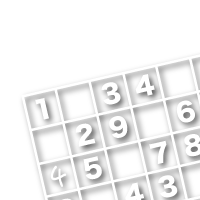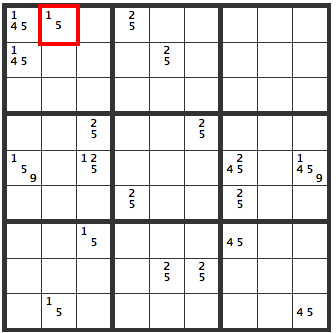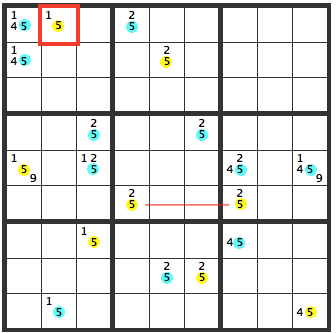

Sponsored Links
TOP > Techniques > Simple Coloring
Solving Techniques 7
Simple Coloring

Suppose the candidate numbers are as pictured. Lets examine [5].

If a [5] is entered in [R1C2], a chain of cells where [5]’s can and cannot be arises.
The yellow indicates [5]’s, the blue indicates [not 5]’s.
In the [25] cells in the middle, both cells will become [5]’s, which is impossible.

If a [1] is entered at [R1C2], this too implies a chain, but it doesn’t end in a contradiction.
The yellow indicates [5]’s, the blue indicates [not 5]’s.
Thus, a single chain is when a problem can be solved at once, by focusing on one number. In this diagram’s case, you have to repeat [5][not 5],[5][not 5], [5][not 5], so it’s not too easy to keep track of.
Sponsored Links
Names of cells in Sudoku
| R1C1 | R1C2 | R1C3 | R1C4 | R1C5 | R1C6 | R1C7 | R1C8 | R1C9 |
| R2C1 | R2C2 | R2C3 | R2C4 | R2C5 | R2C6 | R2C7 | R2C8 | R2C9 |
| R3C1 | R3C2 | R3C3 | R3C4 | R3C5 | R3C6 | R3C7 | R3C8 | R3C9 |
| R4C1 | R4C2 | R4C3 | R4C4 | R4C5 | R4C6 | R4C7 | R4C8 | R4C9 |
| R5C1 | R5C2 | R5C3 | R5C4 | R5C5 | R5C6 | R5C7 | R5C8 | R5C9 |
| R6C1 | R6C2 | R6C3 | R6C4 | R6C5 | R6C6 | R6C7 | R6C8 | R6C9 |
| R7C1 | R7C2 | R7C3 | R7C4 | R7C5 | R7C6 | R7C7 | R7C8 | R7C9 |
| R8C1 | R8C2 | R8C3 | R8C4 | R8C5 | R8C6 | R8C7 | R8C8 | R8C9 |
| R9C1 | R9C2 | R9C3 | R9C4 | R9C5 | R9C6 | R9C7 | R9C8 | R9C9 |
Sponsored Links

